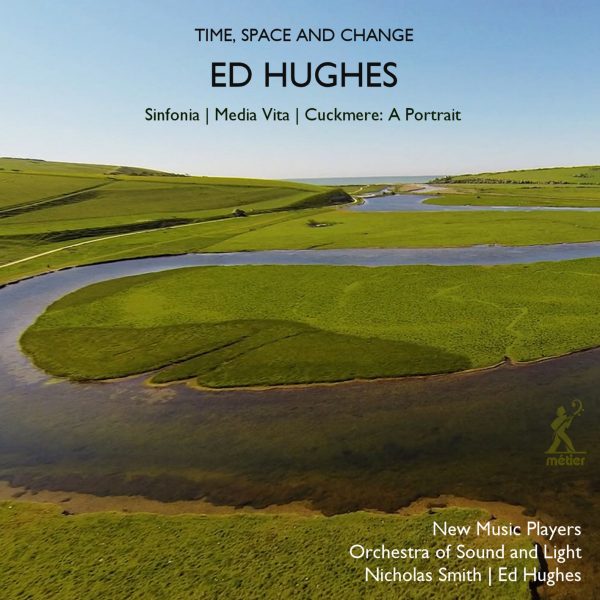The Chronicle Review Corner
All three pieces on this CD — Cuckmere: A Portrait, Media Vita and Sinfonia — focus on historical and geographical landscapes, exploring the cycles of the natural world. While it is clearly modern, Hughes has written scores for silent films and opening piece Cuckmere: A Portrait was originally conceived as a live score for a film. It’s meant to be accessible and, to some extent, not intrusive. Cuckmere depicts a year in the life of the River Cuckmere and Haven, an area of undeveloped flood plain in East Sussex where the river winds across chalk grasslands grazed by sheep and cattle. The winds have created oxbow lakes — anyone familiar with the Dane can at least picture the river. Cuckmere can be summed up in three words: Mike Oldfield Incantations. That album was based around repetitive themes (and is suggesting of landscapes) that suddenly change. The Oldfield is more minimalistic than this and on synths but fans of Oldfield who like orchestral music might find much that is familiar here. (Classical fans could try Incantations too, an enjoyable albeit slightly long double album).
Cuckmere is in eight movements; one for each season, autumn, winter, spring, summer, a prelude, and three interludes.
Media Vita is the earliest work on this CD, written when Hughes was a young graduate, and while Cuckmere flows like the river it portrays, this piece is sharper and more modern.
Sinfonia reaches back into the world of 15th and 16th century English composers. Hughes writes in the sleeve notes: “Sinfonia is the Italian word for symphony (and) also means a small orchestra. However, in this context I am … interested in the word’s connotation of ‘agreement’ or ‘concord of sound’ in the sense of a suite of short movements which are connected”. It’s more abstract than the opening music, particularly in opening piece Agincourt, based on an anonymous English folk song, which captures well both the melee of battle of the joy of survival; Maddy Prior and June Tabor have done versions of the song. By the third movement — Veni Sancte Spiritus, based on a chant or hymn for the Christian Eucharist — the mood is more tranquil, not say upbeat, and again a bit Mike Oldfield.
Closing piece In Nomine is based on the ‘In Nomine’ genre but meant to evoke town criers and stall sellers in 1930s London. We’re impressed with this, modern without being jarring and traditional in sound without being formulaic. The opening Cuckmere is the best section but the whole programme is interesting. The New Music Players (Susanne Stanzeleit, violin, Joe Giddey, cello, and Richard Casey piano), and the Orchestra of Sound and Light (conducted by Nicholas Smith) play.
@divineartrecordingsgroup
A First Inversion Company
Registered Office:
176-178 Pontefract Road, Cudworth, Barnsley S72 8BE
+44 1226 596703
Fort Worth, TX 76110
+1.682.233.4978










![Listen to the full suite of Marcel Dupré’s Variations Sur un Noël, Op. 20 from Alexander Ffinch’s #Expectations release today! listn.fm/expectations [in bio]](https://scontent-dfw5-1.cdninstagram.com/v/t51.71878-15/588904367_2327488161082898_8709236950834211856_n.jpg?stp=dst-jpg_e35_tt6&_nc_cat=105&ccb=7-5&_nc_sid=18de74&efg=eyJlZmdfdGFnIjoiQ0xJUFMuYmVzdF9pbWFnZV91cmxnZW4uQzMifQ%3D%3D&_nc_ohc=H8WFKm530VcQ7kNvwEyxu1V&_nc_oc=AdlbP-daCzbV5Xhy24rxONs3Y1t1ko-OxMhg9wYSjvUnSn34yMKfTBi0oY93R6UsYs0lXVqSY2Ce8tF2X6mMo1Gu&_nc_zt=23&_nc_ht=scontent-dfw5-1.cdninstagram.com&edm=ANo9K5cEAAAA&_nc_gid=jVRZ_hFadonIP5pJXKwPKw&oh=00_Afn6QbXZ_6IWC3zLQmY2OtkoDY1eMDEz5L5hJxOXm2yczQ&oe=6955692A)

![“the ‘Manteca’ Paraphrase – a rare foray into the two-piano medium but here played double-tracked – exudes a panache of which Dizzy Gillespie would surely have approved.… [a] recital well worth investigating.” —Gramophone Magazine with high praise for Ophelia Gordon's debut release, Kapustin: Between the Lines!](https://scontent-dfw5-3.cdninstagram.com/v/t51.82787-15/598796470_18303255136283342_540941604740887837_n.jpg?stp=dst-jpg_e35_tt6&_nc_cat=108&ccb=7-5&_nc_sid=18de74&efg=eyJlZmdfdGFnIjoiRkVFRC5iZXN0X2ltYWdlX3VybGdlbi5DMyJ9&_nc_ohc=IC4zZ7tcpb8Q7kNvwG0AnwY&_nc_oc=Adk-fe0Nme2NQebSWNQYltibA7dHSTiGO9MLWqH2Voah5EWEx839VrXkwi0WyMrWLrXjyyERgCnuiTFzA5XHTU78&_nc_zt=23&_nc_ht=scontent-dfw5-3.cdninstagram.com&edm=ANo9K5cEAAAA&_nc_gid=jVRZ_hFadonIP5pJXKwPKw&oh=00_AflhsAomIZvYr2hjMMLNsTiRvdWSO_i0vOKiGTvhlBPt_A&oe=69554384)